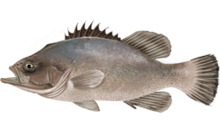Atlantic wreckfish
| Atlantic wreckfish | |
|---|---|

| |
| Scientific classification | |
| Domain: | Eukaryota |
| Kingdom: | Animalia |
| Phylum: | Chordata |
| Class: | Actinopterygii |
| Order: | Perciformes |
| Family: | Polyprionidae |
| Genus: | Polyprion |
| Species: | P. americanus
|
| Binomial name | |
| Polyprion americanus | |
| Synonyms[2] | |
| |
TheAtlantic wreckfish(Polyprion americanus), also known as thestone bassorbass groper(among other names),[3]is amarine,bathydemersal,andoceanodromousray-finned fishin thefamilyPolyprionidae.It has a worldwide, if disjunct, distribution in the Atlantic, Pacific and Indian Oceans.
Description
[edit]The Atlantic wreckfish is a large fish with a deep, robust body and a large head with a protruding lower jaw. The twodorsal finsare joined, the first has 11 spines with the final spine joined onto the second dorsal fin, which has 12 branched rays. Theanal finhas a short base and has three robust spines. Thecaudal finis broad and square. The body is covered with small, firmly attached scales which run up the base of the dorsal and anal fin. It has a large mouth and eyes. Thepreoperculumhas a spiny margin while theoperculumhas a thick bony strut running horizontally at eye level which terminates in a spine. The back and flanks are dark brown in colour with darker spots and blotches fading to yellowish on the belly.[4]They have also been described as being bluish grey on the back with a paler silvery sheen on the underside. The fins are blackish brown.[5]The maximumtotal lengthis 210 centimetres (6.9 ft) with a maximum published weight of 100 kilograms (220 lb).[2]

Distribution
[edit]The Atlantic wreckfish has a disjunct worldwide distribution. It is found in the eastern Atlantic Ocean from Norway to South Africa, into the Mediterranean and including theMacaronesian IslandsandTristan da Cunha.In the western Atlantic it is found fromNewfoundlandtoArgentina.[1][2]In the western Indian Ocean it occurs aroundÎle Saint-PaulandÎle Amsterdamand in the southwestern Pacific Ocean it is found around New Zealand.[2]It is also found off southern Australia from just north ofPerth, Western AustraliatoFraser IslandinQueensland,includingTasmania.[6]
Habitat and biology
[edit]Adult Atlantic wreckfish occur in and around caves, over rocky substrates and areas with densely scattered boulders, natural reefs and shipwrecks, a habitat which has led to species' common name. The adults are deep water fishes which have been recorded at depths between 200 and 600 feet (61 and 183 m). It is normally a solitary species but the adults gather to breed during the summer. The juveniles form shoals for protection from predators which swim and hunt small fish in mid-water. Once they attain a length of 50–75 centimetres (20–30 in) they become solitary and look for aterritoryon the bottom. It is thought that the Atlantic wreckfish can live for as much as ninety years. They feed mainly on bottom-dwelling fish, squid and cuttlefish, but they will also take crustaceans and octopuses. They are probably best described as opportunistic, with one record of a ROV-camera filming a large congregation of small sharks feeding on a deadswordfish,with one of them being caught and swallowed whole by this species of wreckfish.[7]
They have no known predators as adults, but juvenile specimens may be threatened by largebony fishesorsharks.[8]
Conservation and usage
[edit]The Atlantic wreckfish is a commercially valuable species and is valued as a food fish in some parts of its range. Large wreckfish may be divided into steaks, while smaller fish are filleted or baked whole. In North and South America wreckfish are sold frozen in supermarkets or grocery stores or marketed fresh from fish counters. They are caught in trawler nets or by long lines and gill nets, or occasionally by small-scale fisheries which use rod and line. Overall the stock is assessed by theIUCNasdata deficientbut some stocks, such as the Mediterranean stock have been assessed as being at greater risk.[8]
References
[edit]- ^abSadovy, Y.; et al. (Grouper & Wrasse Specialist Group) (2003)."Polyprion americanus".IUCN Red List of Threatened Species.2003:e.T43972A10845280.doi:10.2305/IUCN.UK.2003.RLTS.T43972A10845280.en.Retrieved19 November2021.
- ^abcdFroese, Rainer;Pauly, Daniel (eds.)."Polyprion americanus".FishBase.December 2019 version.
- ^Bray, D. J. (2018)."Polyprion americanus".Fishes of Australia.Retrieved10 August2023.
- ^Alwynne Wheeler(1992).The Pocket Guide to Saltwater Fishes of Britain and Europe.Parkgate Books. p. 93.ISBN1855853647.
- ^"Wreckfish".NOAA.Retrieved2 April2020.
- ^Bray, D.J. (2018)."Polyprion americanus".Fishes of Australia.Museums Victoria.Retrieved2 April2020.
- ^"Scientists Capture Incredibly Rare Footage of Deep-Sea Fish Devouring a Whole Shark".Science Alert.Retrieved11 December2020.
- ^ab"Wreckfish".British Sea Fishing.Retrieved2 April2020.


